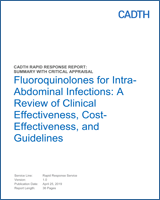SIS (Mazuski),17 2017 US | “to support clinicians in making appropriate treatment decisions and not designed to supplant the judgement of the individual practitioner.” (p2) | Task force comprised of members of the Therapeutics and Guidelines Committee and additional individuals from SIS with subject matter expertise Intended users: clinicians | Subjects were selected from the 2010 guideline for updating Task force chair and working group leaders were appointed by SIS Executive Council. Working groups consisted of additional content experts and Therapeutics and Guidelines Committee The task force chose subjects to update from the previous guideline, developed specific questions, and reviewed RCT evidence published between 2000 and 2016 identified by systematic search of Medline. Additional study designs were considered (not systematic) where gaps existed “Because of the limited quantity of methodologically rigorous studies investigating key questions in the management of IAI, the task force did not undertake a detailed statistical analysis for most of these recommendations, but relied on a process of iterative consensus among task force members to develop the recommendations and their final grading.” (p9) Recommendations were drafted and reviewed by working groups over teleconferences, a face-to-face meeting, and email until consensus was achieved Recommendations were graded according to GRADE Guideline document was reviewed by experts from the SIS, and modified according to reviews by consensus of the task force; it is expected the guideline was externally peer reviewed based on its publication in a scientific journal Task force responded to critiques and forwarded final guideline and supporting materials to SIS Executive Council for final approval. |
EKMUD (Avkan-Oguz),5 2016 Turkey | “To create a standard clinical pathway for the diagnosis and treatment of patients with IAIs.” (p306) | The consensus report development group was led by EKMUD, and comprised of 15 experts in IAI Intended users: physicians in Turkey involved in diagnosis and management of IAIs | Committee met to discuss issues and common practices, delegate subareas among themselves, and screen relevant literature. Literature searches of databases were conducted (unclear inclusion criteria). A supplemental questionnaire was circulated to assess surgeons’ attitude and ability regarding microbiologic sampling in the diagnosis of intra-abdominal infections Recommendations from existing guidelines were discussed (unclear how identified) “all guidelines do not use the same evidence strength table. Therefore, only the evidence grades which were consistent, recommended in both of these guidelines and were also considered appropriate by our expert panel were included in this consensus report with references to the relevant guidelines.” (p307) Recommendations were formulated over 4 meetings, using data from Turkey (unclear what type, as no RCTs were identified and no other data or inclusion criteria were discussed) and referring predominately to 2 guidelines, as well as 7 other guidelines Strength of recommendations and quality of evidence was reported based on an unspecified grading system |
